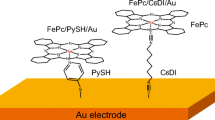Abstract
The electro-reduction of oxygen is effectively catalysed by metal chelates of the N4-type. The mechanism of this process has been found to be a modified ‘redox catalysis’. O2 molecules and the products of their reaction, at least up to H2O2, remain strongly co-ordinated to the central metal ion of the chelates XMeII. The potential-determining step, which regenerates the reduced form, is the following: (XMeIII...O2H)++H++ 2e→XMeII+H2O2.
H2O2 is further decomposed via the catalase action of the electrocatalyst. The mechanism is confirmed by experimental results with iron phthalocyanine (FePc) and cobalt-dibenzotetraazaannulene (CoTAA) as a O2-slurry electrode at various O2 pressures. The latter shows anodic reaction-limited currents, which seem to involve also oxygen-containing intermediates. The implication of the presented mechanism in regard to other electrochemical processes is discussed briefly.
Similar content being viewed by others
References
R. Jasinski,Nature 201 (1964) 1212 andJ. Electrochem. Soc. 112, (1965) 526.
H. Jahnke,Ber. Bunsenges. physik. Chem. 72 (1968) 1053; H. Jahnke and M. Schönborn,III. Journées Int. d'Etude des Piles à Combustible, Compt. red. Bruxelles (1969) 60.
F. Beck, W. Dammert, J. Heiss, H. Hiller and R. Polster,Z. Naturforsch. 28a (1973) 1009.
F. Beck,Ber. Bunsenges. physik. Chem. 77 (1973) 355.
H. Alt, H. Binder, W. Lindner and G. Sandstede,J. Electroanal Chem. 31 (1971) 19.
H. Alt, H. Binder and G. Sandstede,J. Catal. 28 (1973) 8.
H. Jahnke, M. Schönborn and G. Zimmermann,Topics Current Chem. 61 (1976) 133.
M. Savy, P. Andro, C. Bernard and G. Magner,Electrochim. Acta 18 (1973) 191.
J. P. Counter, P. Lenfant and A. K. Vijh,J. Catal. 29 (1973) 8.
F. Haber,Z. anorg. Chem. 51 (1906) 356.
J. P. Hoare, ‘The Electrochemistry of Oxygen’, Interscience, New York (1968).
V. N. Bagotskii, L. N. Nekrassow and N. A. Shumilowa,Russ. Chem. Rev. 34, (1965) 717.
H. Hiller, P. Dimroth and H. Pfitzner,Liebgs Ann. Chem. 717 (1968) 137.
J. Manassen and A. Bar-Ilan,J. Catalysis 17 (1970) 86.
J. P. Randin,Electrochim. Acta 19 (1974) 83.
W. Beyer and F. v. Sturm,Angew. Chem. 84 (1972) 154.
Chr. Kretschmar and K. Wiesener,Z. phys. Chem. (Leipzig)257 (1976) 39.
D. I. Sawyer and L. V. Interrante,J. Electroanal. Chem. 2 (1961) 310
D. I. Sawyer and R. J. Day,Electrochim. Acta 8 (1963) 589.
M. W. Breiter, ‘Electrochemical Processes in Fuel Cells’, Springer, Heidelberg (1969).
H.A. Cook,J. Chem. Soc. (Lond.)1938 (1974) 1761.
M. M. Baizer (Ed.) ‘Organic Electrochemistry’, M. Dekker, New York (1973).
R. Brdička and K. Wiesener,Naturwiss. 31 (1943) 247 andColl. Czech. Chem. Comm. 12 (1947) 39.
J. Koutečky, R. Brdička and V. Hanus,Coll. Czech. Chem. Comm. 18 (1953) 611.
I. M. Kolthoff and E. P. Parry,J. Amer. Chem. Soc. 73 (1951) 3718.
H. Gerischer and J. Gobrecht,Ber. Bunsenges. physik. Chem. 80 (1976) 327.
F. BeckJ. Electroanal. Chem. (to be published).
D. Vonderschmitt, K. Bernauer and S. Fallab,Helv. Chim. Acta 48 (1965) 951
H. Kropf,Liebigs Ann. Chem 637 (1960) 73.
E. Willihnganz,J. Electrochem. Soc. 100 (1953) 527.
Author information
Authors and Affiliations
Rights and permissions
About this article
Cite this article
Beck, F. The redox mechanism of the chelate-catalysed oxygen cathode. J Appl Electrochem 7, 239–245 (1977). https://doi.org/10.1007/BF00618991
Received:
Issue Date:
DOI: https://doi.org/10.1007/BF00618991




